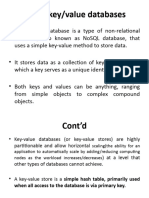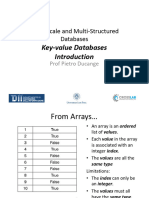0% found this document useful (0 votes)
34 views17 pagesKey-Value Databases
Key-value stores are simple NoSQL databases that allow operations on key-value pairs, offering high performance and scalability. They are suitable for use cases like storing session information, user profiles, and shopping cart data, but are not ideal for scenarios requiring complex relationships, multioperation transactions, or querying by data attributes. Popular key-value databases include Riak, Redis, and Amazon DynamoDB, each with unique features and limitations.
Uploaded by
Deepika ChandrashekarCopyright
© © All Rights Reserved
We take content rights seriously. If you suspect this is your content, claim it here.
Available Formats
Download as PPTX, PDF, TXT or read online on Scribd
0% found this document useful (0 votes)
34 views17 pagesKey-Value Databases
Key-value stores are simple NoSQL databases that allow operations on key-value pairs, offering high performance and scalability. They are suitable for use cases like storing session information, user profiles, and shopping cart data, but are not ideal for scenarios requiring complex relationships, multioperation transactions, or querying by data attributes. Popular key-value databases include Riak, Redis, and Amazon DynamoDB, each with unique features and limitations.
Uploaded by
Deepika ChandrashekarCopyright
© © All Rights Reserved
We take content rights seriously. If you suspect this is your content, claim it here.
Available Formats
Download as PPTX, PDF, TXT or read online on Scribd
/ 17






























































































